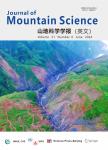Impact of land cover change on land surface temperature: A case study of Spiti Valley
Impact of land cover change on land surface temperature: A case study of Spiti Valley作者机构:Department of Geography Delhi School of Economics University of Delhi Department of Geography Kalindi College University of Delhi
出 版 物:《Journal of Mountain Science》 (山地科学学报(英文))
年 卷 期:2018年第15卷第8期
页 面:1658-1670页
核心收录:
学科分类:0709[理学-地质学] 0819[工学-矿业工程] 09[农学] 0303[法学-社会学] 0708[理学-地球物理学] 0818[工学-地质资源与地质工程] 0705[理学-地理学] 0815[工学-水利工程] 0706[理学-大气科学] 0816[工学-测绘科学与技术] 0813[工学-建筑学] 0704[理学-天文学] 0833[工学-城乡规划学] 0713[理学-生态学] 0834[工学-风景园林学(可授工学、农学学位)]
基 金:part of my M.phil research work completed in Department of Geography Delhi School of Economics University of Delhi
主 题:Land surface temperature Land cover change Normalised difference snow index Normalised Difference Vegetation Index DEM Remote Sensing GIS Linear Regression
摘 要:Land surface temperature(LST) is the skin temperature of the earth surface. LST depends on the amount of sunlight received by any geographical area. Apart from sun light, LST is also affected by the land cover, which leads to change in land surface temperature. Impact of land cover change(LCC) on LST has been assessed using Landsat TM5, Landsat 8 TIRS/OLI and Digital Elevation Model(ASTER) for Spiti Valley, Himachal Pradesh, India. In the present study, Spiti valley was divided into three altitudinal zones to check the pattern of changing land cover along different altitudes and LST was calculated for all the four land cover categories extracted from remote sensing data for the years of 1990 and 2015. Matrix table was used as a technique to evaluate the land cover change between two different years. Matrix table shows that as a whole, about 2,151,647 ha(30%) area of Spiti valley experienced change in land cover in the last 25 years. The result also shows vegetation and water bodies increased by 107,560.2 ha(605.87%) and 45 ha(0.98%), respectively. Snow cover and barren land decreased by 19,016.5 ha(23.92%) and 88,589(14.14%), during the study period. A significant increase has been noticed in vegetation amongst all land cover types. Minimum, maximum and mean LST for three altitudinal zones have been calculated. The mean LST recorded was 11℃ in 1990 but it rose by 2℃ and reached to 13℃ in 2015. Changes in LST were obtained for each land cover categories. The mean temperature of different land cover types was calculated by averaging value of all pixels of a given land cover types. The mean LST of vegetation, barren land, snow cover and water body increased by 6℃, 9℃, 1℃, and 7℃, respectively. Further, relationships between LST, Normalized Difference Snow Index(NDSI), and Normalised Difference Vegetation Index(NDVI) were established using Linear Regression.



